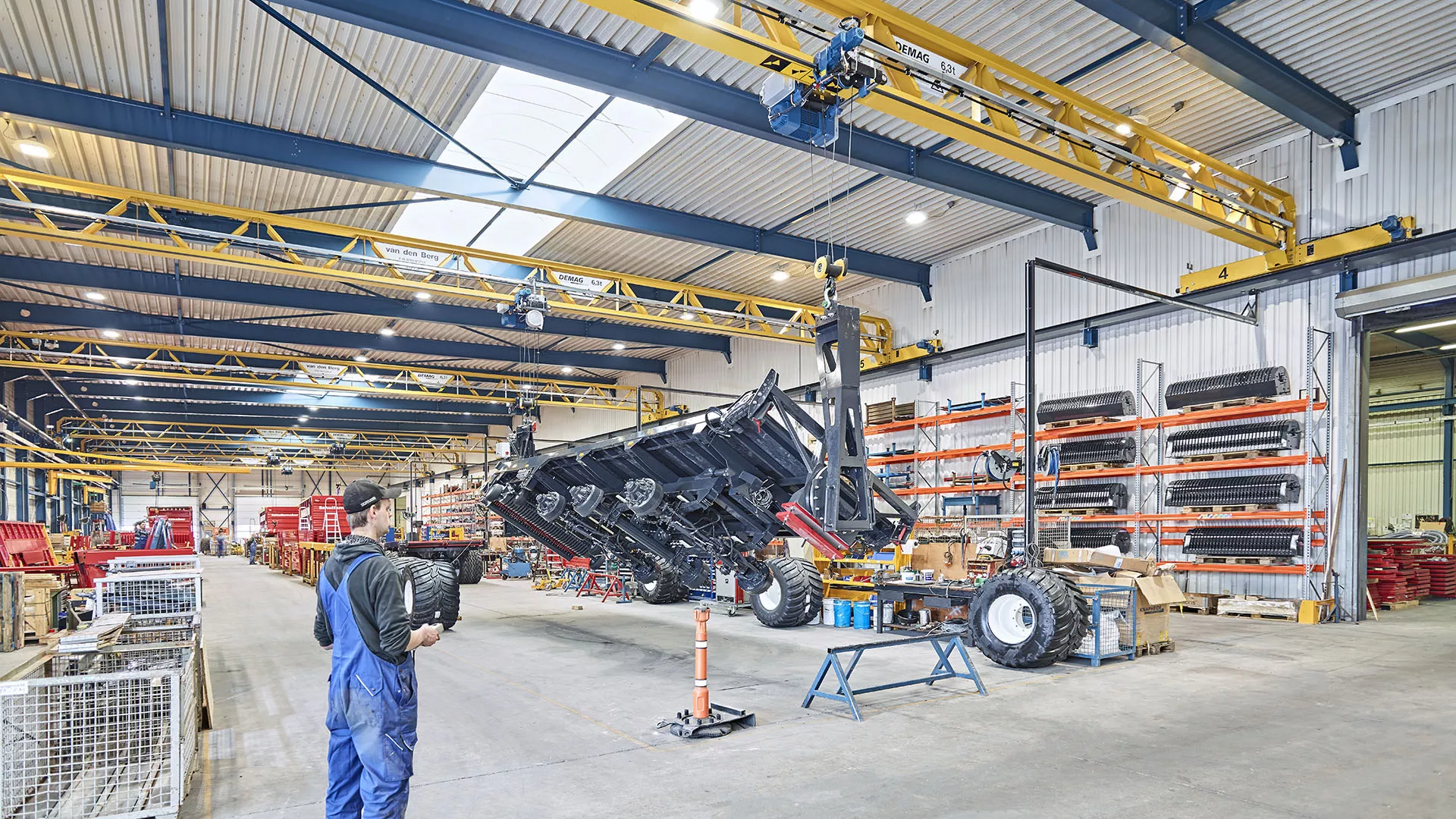
V-type cranes support final assembly
Schuitemaker
More light in production
The Netherlands-based agricultural machinery manufacturer Schuitemaker has trimmed its production to achieve significantly shorter throughput times by restructuring its final assembly operation. All steps for series assembly have been merged into a linear production process. The staff in the newly created workshop area are supported by cranes at almost every step in assembly. Schuitemaker invested in a total of eleven Demag V-type cranes, as their open girder architecture met in full the previously defined requirements for ergonomics, precision and energy efficiency.
In the agricultural sector, Schuitemaker has gained a solid reputation well beyond the borders of the Netherlands. Since it was established as a village smithy almost 100 years ago, the company has grown into a specialized manufacturer of high-quality agricultural machinery. Products by Schuitemaker are used for fodder production, feeding and manure spreading wherever animals are raised for meat or kept for dairy products. At the location in Rijssen in the east of the Netherlands, some 180 employees develop and manufacture feeder wagons, silage wagons and animal feed distribution wagons. Production follows seasonal demand. Johan H. Veenstra, CEO at Schuitemaker notes: “Besides serving our domestic market, we export to more than 30 countries all over the world. We offer our machinery in the premium segment and place very high quality standards on our products, which we manufacture to order in a short time.”
The focus was on gradual development when the company started planning today’s Building 12 some years ago. The intended part of the production area, which measures 40,000 m² in total, was initially used as a store before preparations began to extend production capacities. Johan H. Veenstra: “As a family-owned company, we always consider the long-term perspective. That is why we already considered its later use as an assembly workshop when we constructed the building six years ago.”
The goal was to include all final assembly activities for the agricultural machinery in one line. For this purpose, Building 12 (measuring 102 x 22 m) was equipped with four stations for pre-assembly and seven final assembly workplaces. For quality and delivery performance reasons, Schuitemaker places great emphasis on in-house production. From the chassis and metering rollers to side panels, most of the components are manufactured on site and transported by forklift to the final assembly line for installation.
As much lifting capacity as necessary, as discretely as possible
To position the parts as needed, however, the company relies completely on crane systems, which help to move and install elements, some of which weigh many tons. The decision in favor of the crane systems was based on the principle of ‘as much lifting capacity as necessary, as discretely as possible’:
- Support for the assembly workers by precise positioning of the structural elements
- Optional use in tandem mode for bulky and heavy parts
- Optical integration of the cranes into the building structure incorporating ergonomic requirements
The last of the items listed above played a decisive role in the choice of the crane systems. Since the work involves only assembly activities, the cranes were to remain as unobtrusive as possible and any effects on the lighting situation resulting from crane travel motions were to be kept as low as possible for the working area beneath them. Johan H. Veenstra: “Due to the quantity of assembly stations, we need a larger number of cranes on one runway. This makes it all the more important to minimize the shadows that are caused when a crane passes above a workplace, which impacts the ability of our people to concentrate on their work. That is why we decided in favor of Demag V-type cranes, which have an open girder design that allows as much light as possible to fall on the workplaces.”
Nine EVKE V-type single-girder cranes travel on the 102-m-long crane runway, which was installed at a height of 6.80 m. The cranes have a span of 21.125 m and are each equipped with a 6.3 t Demag rope hoist. Schuitemaker’s assembly personnel control the cranes by radio at a safe and convenient distance to the load. At the press of a button, six of the new cranes can be operated in tandem to safely position the heavy pieces of machinery, which can weigh up to 10 t.
Consulting, planning and installation of the cranes were provided by the Den Haag-based company van den Berg Transporttechniek, which has been the agent for Demag cranes and hoists in the Netherlands and Belgium for many years.
Assembly with parts turned 180 degrees
Assembly of a wagon starts with the platform, which is initially delivered on its back and deposited at the first assembly station by a tandem crane arrangement. After the axles have been installed, two cranes pick up a motor-driven turning jig, which was developed and manufactured by Schuitemaker itself. It is used to turn the vehicle chassis by 180 degrees. The tires are then installed and the unfinished wagon is attached to an electric towing device, which transports it from one assembly station to the next.
“Besides the economic aspects, precise handling of the components to be installed was important for selection of the crane equipment”, explains Johan H. Veenstra. “The installation of the side panels is one example of this. The process to insert these elements, which can weigh several tons, involves minimum tolerances. Our team manages these tasks without any problems with the V-type cranes. And as far as the lower weight of the crane girders is concerned, it is self-evident that we can also save energy by using motors that have lower outputs.”
V-type cranes serve welding robot
Schuitemaker has also invested extensively in the upstream production areas. The installation of a large welding robot in Production Bay 2 represents an important step for future growth. The mechanical engineering company is gradually concentrating all steelwork fabrication, such as for platforms and chassis, in this area.
Johan H. Veenstra: “This installation clearly makes us a leader in terms of speed and efficiency. The use of carbon as a material for the superstructure has enabled the weight to be cut by 7,500 kg. Thanks to this, we save a significant amount of time and energy, since the welding gantry enables us to cut throughput times by up to 80 per cent.”
In this section of Bay 2, two V-type cranes that have a span of 26 m are used to transport the large-format parts, which measure up to 12 m in length, from the preparation area to the welding gantry – and back to the paint shop after the parts have been welded. Due to the lengths of the parts and their weights of up 10 t, the cranes are mostly used in tandem. Thanks to radio control, the staff can also operate the equipment here at a safe distance to the load.
Smooth crane assembly – fast production ramp-up
The total of eleven Demag V-type cranes were assembled and commissioned by van den Berg within four weeks. Consequently, the linear production process was able to start without delay. The service department of the Demag agent van den Berg ensures that the new cranes will also have a high level of availability in the future. The service technicians have been maintaining the cranes and hoists at Schuitemaker for many years – also including some Demag chain hoists that were installed when production began at the Rijssen location in 1965. The service team is responsible for a total of some 110 installations, which are regularly serviced and maintained.
Improved production and delivery performance
With the restructuring of its assembly line and the installation of the large portal welding robot, the agricultural machinery manufacturer Schuitemaker has taken an important step for future growth.
Johan H. Veenstra: “Purely order-based production as in the automotive industry, for example, cannot be done for the agricultural sector, since the orders are placed at very short notice. We have to build and deliver the machinery for our customers quickly according to seasonal demand. Thanks to our new manufacturing structures, we can meet this demand more quickly – and unlock the opportunity for further delivery performance improvements with the possibility of multi-shift operation. The V-type cranes support our assembly teams in terms of ergonomics and safety, which enables us to achieve our high standards of quality with certainty and reliability.”






